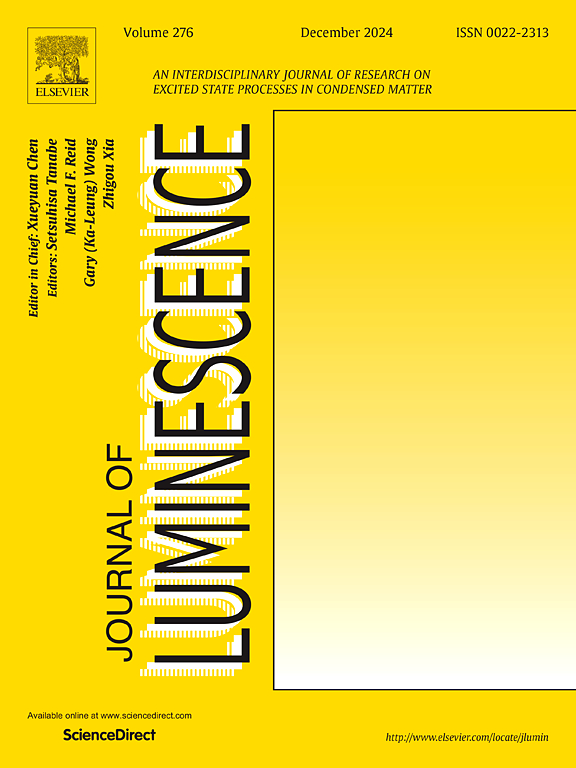Substitution induced solvatochromism behaviour of blue emissive N-aryl pyrazoline derivatives and DFT studies
IF 3.3
3区 物理与天体物理
Q2 OPTICS
引用次数: 0
Abstract
In the present investigation, a series of 5-[4-(benzyloxy)phenyl]-3-(thiophen-2-yl)-4,5-dihydro-1H-pyrazole derivatives (A-E) were successfully synthesized via the cyclization of (2E)-3-[4-(benzyloxy)phenyl]-1-(thiophen-2-yl)prop-2-en-1-one (1) with differently substituted phenyl hydrazine respectively. The substituents on the para position of phenyl ring were methyl (-CH3), bromine (-Br) cyano (-CN) and nitro (-NO2) groups, leading to the formation of distinct pyrazoline derivatives. This study highlights the influence of different substituents as well as solvents on the potential physicochemical properties of these synthesized pyrazoline derivatives. To investigate the absorption and emission behaviours of the pyrazoline derivatives in various polar and nonpolar solvents; the solvent-solute interactions were analyzed using the solvent polarity parameter approach and Lipperte-Mataga equation. In polar solvents the compounds A-D exhibited higher Stokes shifts than nonpolar solvents. So the change in excited state intermolecular interactions such as H-bonding brought changes in dipole moments. These derivatives were evaluated for their fluorescence quantum yield (QY) which exhibited fluorescence emission in blue region, as confirmed by CIE diagram. The QY was also effected by polarity of the solvents as compounds A-D gave least QY in methanol compared to BuOH. The solid state absorption and emission spectral analysis indicated red shift in the emission spectra than in solvents with highest for compound E (-NO2) which could be accounted for J-aggregation in the solid state. These aggregation patterns changed in solution state. The compound E did not show any emission in the polar solvents due to quenching. Additionally, Density functional theory (DFT) calculations were conducted to evaluate the optimized theoretical molecular geometry and frontier molecular orbital properties of the five synthesized organic molecules indicated their semiconductor behaviour. These results provide an avenue to consider the pyrazoline molecules as excellent luminescent materials.

取代诱导蓝辐射n -芳基吡唑啉衍生物的溶剂致变色行为及DFT研究
本研究通过(2E)-3-[4-(苯氧基)苯基]-1-(噻吩-2-基)prop-2-en-1-one(1)与不同取代的苯肼环化,成功合成了一系列5-[4-(苯氧基)苯基]-3-(噻吩-2-基)-4,5-二氢- 1h -吡唑衍生物(a -e)。苯基环对位上的取代基为甲基(-CH3)、溴(-Br)、氰基(-CN)和硝基(-NO2),形成了不同的吡唑啉衍生物。本研究强调了不同取代基和溶剂对这些合成的吡唑啉衍生物的潜在物理化学性质的影响。研究吡唑啉衍生物在各种极性和非极性溶剂中的吸收和发射行为;采用溶剂极性参数法和Lipperte-Mataga方程分析了溶剂-溶质相互作用。在极性溶剂中,化合物A-D比非极性溶剂表现出更高的斯托克斯位移。所以激发态分子间相互作用的变化,比如氢键,带来了偶极矩的变化。这些衍生物的荧光量子产率(QY)由CIE图证实,在蓝色区域有荧光发射。溶剂的极性也会影响QY,与BuOH相比,化合物A-D在甲醇中的QY最小。固体吸收光谱和发射光谱分析表明,化合物E (-NO2)的发射光谱比溶剂中的红移最高,这可能是固体中j聚集的原因。这些聚合模式在解决方案状态下发生了变化。化合物E在极性溶剂中由于猝灭而不表现出任何发射。此外,通过密度泛函理论(DFT)计算对优化后的理论分子几何结构进行了评价,并对5种合成有机分子的前沿分子轨道性质进行了表征。这些结果为考虑吡唑啉分子作为优良的发光材料提供了一条途径。
本文章由计算机程序翻译,如有差异,请以英文原文为准。
求助全文
约1分钟内获得全文
求助全文
来源期刊

Journal of Luminescence
物理-光学
CiteScore
6.70
自引率
13.90%
发文量
850
审稿时长
3.8 months
期刊介绍:
The purpose of the Journal of Luminescence is to provide a means of communication between scientists in different disciplines who share a common interest in the electronic excited states of molecular, ionic and covalent systems, whether crystalline, amorphous, or liquid.
We invite original papers and reviews on such subjects as: exciton and polariton dynamics, dynamics of localized excited states, energy and charge transport in ordered and disordered systems, radiative and non-radiative recombination, relaxation processes, vibronic interactions in electronic excited states, photochemistry in condensed systems, excited state resonance, double resonance, spin dynamics, selective excitation spectroscopy, hole burning, coherent processes in excited states, (e.g. coherent optical transients, photon echoes, transient gratings), multiphoton processes, optical bistability, photochromism, and new techniques for the study of excited states. This list is not intended to be exhaustive. Papers in the traditional areas of optical spectroscopy (absorption, MCD, luminescence, Raman scattering) are welcome. Papers on applications (phosphors, scintillators, electro- and cathodo-luminescence, radiography, bioimaging, solar energy, energy conversion, etc.) are also welcome if they present results of scientific, rather than only technological interest. However, papers containing purely theoretical results, not related to phenomena in the excited states, as well as papers using luminescence spectroscopy to perform routine analytical chemistry or biochemistry procedures, are outside the scope of the journal. Some exceptions will be possible at the discretion of the editors.
 求助内容:
求助内容: 应助结果提醒方式:
应助结果提醒方式:


